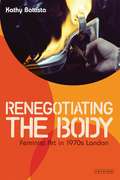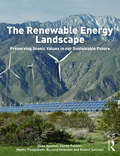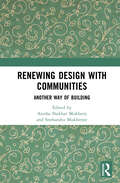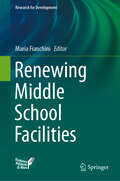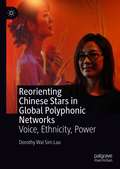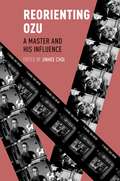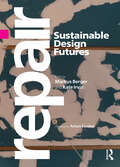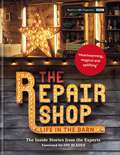- Table View
- List View
Renegotiating the Body: Feminist Art in 1970s London
by Kathy BattistaWhat makes art 'feminist art'? Although feminist artists do have a unique aesthetic, there can be no essential feminist aesthetic, argues Kathy Battista in this exciting new art history. Domesticity, the body, its traces and sexuality have become prominent themes in contemporary feminist practice but where did these preoccupations begin and how did they come to signify a particular type of art? Kathy Battista's (re-)engagement with the founding generation of female practitioners centres on 1970s London as the cultural hub from which a new art practice arose. Emphasising the importance of artists including Bobby Baker, Anne Bean, Catherine Elwes, Rose English, Alexis Hunter, Tina Keane, Hannah O'Shea, Kate Walker and Silvia Ziranek and examining works such as Mary Kelly's Post-Partum Document, Judy Clark's 1973 exhibition Issues, Carolee Schneemann's Meat Joy and Cosey Fanni Tutti's Prostitution, shown in 1976, Kathy Battista investigates some of the most controversial and provocative art from the era. This book not only deals with the 'famous' art events but includes analysis of lesser-known exhibitions and performances and explains why so much feminist art has been both marginalised in art history and grossly under-represented in institutional archives and collections.
ReNew Town: Adaptive Urbanism and the Low Carbon Community (Routledge Contemporary Asia Ser.)
by Andrew Scott Eran Ben-JosephReNew Town puts forth an innovative vision of performative design and planning for low-carbon sustainable development, and illustrates practicable strategies for balancing environmental systems with urban infrastructure and new housing prototypes. To date, much of the discourse on the design of sustainable communities and ‘eco-cities’ has been premised on using previously undeveloped land. In contrast, this book and the project it showcases focus on the retrofitting and adaptation of an existing environment – a more common problem, given the extent of the world’s already-built infrastructure. Employing a ‘research through design’ model of inquiry, the book focuses on large-scale housing developments – especially those built around the world between the 1960s and the early 1980s – with the aim of understanding how best to reinvent them. At the center of the book is Tama New Town, a planned community outside Tokyo that faces a range of challenges, such as an aging population, the deterioration of homes and buildings, and economic stagnation. The book begins by outlining a series of principles that structure the ecological and energy goals for the community. It then develops prototypical solutions for designing, building and retrofitting neighborhoods. The intent is that these prototypes could be applied to similar urban conditions around the world. ReNew Town is the product of a collaborative design research project at the Massachusetts Institute of Technology (MIT) School of Architecture and Planning, and Japan’s Sekisui House LTD.
ReNew Town: Adaptive Urbanism and the Low Carbon Community
by Andrew Scott Eran Ben-JosephReNew Town puts forth an innovative vision of performative design and planning for low-carbon sustainable development, and illustrates practicable strategies for balancing environmental systems with urban infrastructure and new housing prototypes. To date, much of the discourse on the design of sustainable communities and ‘eco-cities’ has been premised on using previously undeveloped land. In contrast, this book and the project it showcases focus on the retrofitting and adaptation of an existing environment – a more common problem, given the extent of the world’s already-built infrastructure. Employing a ‘research through design’ model of inquiry, the book focuses on large-scale housing developments – especially those built around the world between the 1960s and the early 1980s – with the aim of understanding how best to reinvent them. At the center of the book is Tama New Town, a planned community outside Tokyo that faces a range of challenges, such as an aging population, the deterioration of homes and buildings, and economic stagnation. The book begins by outlining a series of principles that structure the ecological and energy goals for the community. It then develops prototypical solutions for designing, building and retrofitting neighborhoods. The intent is that these prototypes could be applied to similar urban conditions around the world. ReNew Town is the product of a collaborative design research project at the Massachusetts Institute of Technology (MIT) School of Architecture and Planning, and Japan’s Sekisui House LTD.
Renewable Energy and Sustainable Buildings: Selected Papers from the World Renewable Energy Congress WREC 2018 (Innovative Renewable Energy)
by Ali SayighThis book contains selected papers presented during the World Renewable Energy Network’s 28thanniversary congress at the University of Kingston in London. The forum highlighted the integration of renewables and sustainable buildings as the best means to combat climate change. In-depth chapters written by the world’s leading experts highlight the most current research and technological breakthroughs and discuss policy, renewable energy technologies and applications in all sectors – for heating and cooling, agricultural applications, water, desalination, industrial applications and for the transport sectors.Presents cutting-edge research in green building and renewable energy from all over the world;Covers the most up-to-date research developments, government policies, business models, best practices and innovations;Contains case studies and examples to enhance practical application of the technologies.
Renewable Energy for Buildings: Technology, Control, and Operational Techniques (Green Energy and Technology)
by Milad Sadat-Mohammadi Morteza Nazari-Heris Somayeh Asadi Behnam Mohammadi-Ivatloo Houtan JebelliThe book covers practical applications and experimental results of integrating renewable energy technologies, energy storage facilities, and intelligent control and operation techniques into building energy systems. It introduces practical approaches to improving the energy systems of buildings in order to reduce energy consumption and cost. Renewable Energy for Buildings is suitable for retrofit engineers, energy engineers, and professionals, as well as researchers and developers in electrical engineering, architectural engineering, and mechanical engineering. Moreover, it can be used by undergraduate and graduate students to become familiar with the most recent developments in building energy systems.Examines the most recent developments in building energy systems;Looks at practical applications and theoretical aspects; Includes case studies.
The Renewable Energy Landscape: Preserving Scenic Values in our Sustainable Future
by Dean Apostol James Palmer Martin Pasqualetti Richard Smardon Robert SullivanWinner of the 2017 EDRA Great Places Award (Research Category) Winner of the 2017 VT ASLA Chapter Award of Excellence (Communications Category) The Renewable Energy Landscape is a definitive guide to understanding, assessing, avoiding, and minimizing scenic impacts as we transition to a more renewable energy future. It focuses attention, for the first time, on the unique challenges solar, wind, and geothermal energy will create for landscape protection, planning, design, and management. Topics addressed include: Policies aimed at managing scenic impacts from renewable energy development and their social acceptance within North America, Europe and Australia Visual characteristics of energy facilities, including the design and planning techniques for avoiding or mitigating impacts or improving visual fit Methods of assessing visual impacts or energy projects and the best practices for creating and using visual simulations Policy recommendations for political and regulatory bodies. A comprehensive and practical book, The Renewable Energy Landscape is an essential resource for those engaged in planning, designing, or regulating the impacts of these new, critical energy sources, as well as a resource for communities that may be facing the prospect of development in their local landscape.
The Renewable Energy Landscape: Preserving Scenic Values in our Sustainable Future
by Dean Apostol James Palmer Martin Pasqualetti Richard Smardon Robert SullivanWinner of the 2017 EDRA Great Places Award (Research Category) Winner of the 2017 VT ASLA Chapter Award of Excellence (Communications Category) The Renewable Energy Landscape is a definitive guide to understanding, assessing, avoiding, and minimizing scenic impacts as we transition to a more renewable energy future. It focuses attention, for the first time, on the unique challenges solar, wind, and geothermal energy will create for landscape protection, planning, design, and management. Topics addressed include: Policies aimed at managing scenic impacts from renewable energy development and their social acceptance within North America, Europe and Australia Visual characteristics of energy facilities, including the design and planning techniques for avoiding or mitigating impacts or improving visual fit Methods of assessing visual impacts or energy projects and the best practices for creating and using visual simulations Policy recommendations for political and regulatory bodies. A comprehensive and practical book, The Renewable Energy Landscape is an essential resource for those engaged in planning, designing, or regulating the impacts of these new, critical energy sources, as well as a resource for communities that may be facing the prospect of development in their local landscape.
Renewable Energy Resources
by John TwidellRenewable Energy Resources is a numerate and quantitative text. It covers the many renewables technologies implemented worldwide by harnessing sustainable resources, mitigating pollution and climate change, and providing cost effective services. This fourth edition is extensively updated by John Twidell with global developments as underpinned by fundamental analysis and illustrated by case studies and worked examples. Efficiency of end-use and cost-effectiveness is emphasized. Each chapter begins with fundamental scientific theory, and then considers applications, environmental impact and socio-economic aspects, before concluding with Quick Questions for self-revision, Problems and new Exercises. Basic theory underlying the technologies is covered in succinct Reviews of electrical power, fluid dynamics, heat transfer and solid-state physics. Common symbols and cross-referencing apply throughout; essential data are tabulated in Appendices. Renewable Energy Resources supports multidisciplinary master’s degrees in science and engineering, and specialist modules at undergraduate level. Practicing scientists and engineers will find it a useful introductory text and reference book.
Renewable Energy Resources
by John TwidellRenewable Energy Resources is a numerate and quantitative text. It covers the many renewables technologies implemented worldwide by harnessing sustainable resources, mitigating pollution and climate change, and providing cost effective services. This fourth edition is extensively updated by John Twidell with global developments as underpinned by fundamental analysis and illustrated by case studies and worked examples. Efficiency of end-use and cost-effectiveness is emphasized. Each chapter begins with fundamental scientific theory, and then considers applications, environmental impact and socio-economic aspects, before concluding with Quick Questions for self-revision, Problems and new Exercises. Basic theory underlying the technologies is covered in succinct Reviews of electrical power, fluid dynamics, heat transfer and solid-state physics. Common symbols and cross-referencing apply throughout; essential data are tabulated in Appendices. Renewable Energy Resources supports multidisciplinary master’s degrees in science and engineering, and specialist modules at undergraduate level. Practicing scientists and engineers will find it a useful introductory text and reference book.
Renewable Energy Resources
by John Twidell Tony WeirRenewable Energy Resources is a numerate and quantitative text covering the full range of renewable energy technologies and their implementation worldwide. Energy supplies from renewables (such as from biofuels, solar heat, photovoltaics, wind, hydro, wave, tidal, geothermal, and ocean-thermal) are essential components of every nation’s energy strategy, not least because of concerns for the local and global environment, for energy security and for sustainability. Thus in the years between the first and this third edition, most renewable energy technologies have grown from fledgling impact to significant importance because they make good sense, good policy and good business. This Third Edition is extensively updated in light of these developments, while maintaining the book’s emphasis on fundamentals, complemented by analysis of applications. Renewable energy helps secure national resources, mitigates pollution and climate change, and provides cost effective services. These benefits are analysed and illustrated with case studies and worked examples. The book recognises the importance of cost effectiveness and efficiency of end-use. Each chapter begins with fundamental scientific theory, and then considers applications, environmental impact and socio-economic aspects before concluding with Quick Questions for self-revision and Set Problems. The book includes Reviews of basic theory underlying renewable energy technologies, such as electrical power, fluid dynamics, heat transfer and solid-state physics. Common symbols and cross-referencing apply throughout; essential data are tabulated in appendices. An associated eResource provides supplementary material on particular topics, plus a solutions guide to Set Problems. Renewable Energy Resources supports multi-disciplinary master degrees in science and engineering, and specialist modules in first degrees. Practising scientists and engineers who have not had a comprehensive training in renewable energy will find it a useful introductory text and a reference book.
Renewable Energy Resources
by John Twidell Tony WeirRenewable Energy Resources is a numerate and quantitative text covering the full range of renewable energy technologies and their implementation worldwide. Energy supplies from renewables (such as from biofuels, solar heat, photovoltaics, wind, hydro, wave, tidal, geothermal, and ocean-thermal) are essential components of every nation’s energy strategy, not least because of concerns for the local and global environment, for energy security and for sustainability. Thus in the years between the first and this third edition, most renewable energy technologies have grown from fledgling impact to significant importance because they make good sense, good policy and good business. This Third Edition is extensively updated in light of these developments, while maintaining the book’s emphasis on fundamentals, complemented by analysis of applications. Renewable energy helps secure national resources, mitigates pollution and climate change, and provides cost effective services. These benefits are analysed and illustrated with case studies and worked examples. The book recognises the importance of cost effectiveness and efficiency of end-use. Each chapter begins with fundamental scientific theory, and then considers applications, environmental impact and socio-economic aspects before concluding with Quick Questions for self-revision and Set Problems. The book includes Reviews of basic theory underlying renewable energy technologies, such as electrical power, fluid dynamics, heat transfer and solid-state physics. Common symbols and cross-referencing apply throughout; essential data are tabulated in appendices. An associated eResource provides supplementary material on particular topics, plus a solutions guide to Set Problems. Renewable Energy Resources supports multi-disciplinary master degrees in science and engineering, and specialist modules in first degrees. Practising scientists and engineers who have not had a comprehensive training in renewable energy will find it a useful introductory text and a reference book.
Renewable Energy Systems for Building Designers: Fundamentals of Net Zero and High Performance Design
by Dorothy GerringRenewable Energy Systems for Building Designers presents a comprehensive introduction to the latest resources and technologies used in high performance and net zero energy buildings, with a practical focus on the design and integration of these systems. This textbook and convenient reference offers a single-source guide to renewable technologies, balancing broad knowledge with the details of implementation crucial for successful sustainable design. It equips students and professionals with foundations and critical information needed to confidently plan for and meet the highest standards of energy efficiency in new construction and retrofitted buildings. Part I of the book establishes key principles of renewable systems, power production, and design for climate, introducing energy modeling and measurements of performance. Part II focuses in more depth on renewable energy systems, including photovoltaics, heat pumps, solar thermal, and more. Dedicated chapters break down the fundamental concepts behind each renewable technology and present guidelines for configuration and installation including system requirements, equipment specification, sizing, and location of components. Part III discusses topics relevant across renewable systems, including energy storage, control and monitoring, and cost/payback calculation. Part IV comprises case studies of exemplary renewable energy projects. Features: Covers resources and technologies including photovoltaics, solar thermal hot water, heat pumps, biomass, wind and microhydro turbines, marine renewable energy, deep cycle rechargeable batteries, and system controllers. Compiles up-to-date, essential information on designing with renewable systems in one location, organized by technology for easy reference. Presents clear explanations of all concepts and system aspects, using US/SI units and full-color diagrams and illustrations throughout. Features case studies of renewable energy systems in completed projects, demonstrating a range of climate specific applications. Includes study questions, a comprehensive guide to terminology and acronyms, spreadsheets for calculations, system sizing worksheets, and additional online resources. Renewable Energy Systems for Building Designers: Fundamentals of Net Zero and High Performance Design will serve as an essential introduction and enduring reference for students of architecture, engineering, construction, and building science. Equally valuable as a professional resource, it will quickly become the go-to guide for energy efficient design for practitioners in these areas.
Renewable Energy Systems for Building Designers: Fundamentals of Net Zero and High Performance Design
by Dorothy GerringRenewable Energy Systems for Building Designers presents a comprehensive introduction to the latest resources and technologies used in high performance and net zero energy buildings, with a practical focus on the design and integration of these systems. This textbook and convenient reference offers a single-source guide to renewable technologies, balancing broad knowledge with the details of implementation crucial for successful sustainable design. It equips students and professionals with foundations and critical information needed to confidently plan for and meet the highest standards of energy efficiency in new construction and retrofitted buildings. Part I of the book establishes key principles of renewable systems, power production, and design for climate, introducing energy modeling and measurements of performance. Part II focuses in more depth on renewable energy systems, including photovoltaics, heat pumps, solar thermal, and more. Dedicated chapters break down the fundamental concepts behind each renewable technology and present guidelines for configuration and installation including system requirements, equipment specification, sizing, and location of components. Part III discusses topics relevant across renewable systems, including energy storage, control and monitoring, and cost/payback calculation. Part IV comprises case studies of exemplary renewable energy projects. Features: Covers resources and technologies including photovoltaics, solar thermal hot water, heat pumps, biomass, wind and microhydro turbines, marine renewable energy, deep cycle rechargeable batteries, and system controllers. Compiles up-to-date, essential information on designing with renewable systems in one location, organized by technology for easy reference. Presents clear explanations of all concepts and system aspects, using US/SI units and full-color diagrams and illustrations throughout. Features case studies of renewable energy systems in completed projects, demonstrating a range of climate specific applications. Includes study questions, a comprehensive guide to terminology and acronyms, spreadsheets for calculations, system sizing worksheets, and additional online resources. Renewable Energy Systems for Building Designers: Fundamentals of Net Zero and High Performance Design will serve as an essential introduction and enduring reference for students of architecture, engineering, construction, and building science. Equally valuable as a professional resource, it will quickly become the go-to guide for energy efficient design for practitioners in these areas.
Renewing Design with Communities: Another Way of Building
by Anisha Shekhar Mukherji and Snehanshu MukherjeeThis book looks at alternative ways of analyzing traditional and contemporary architectural design and building practices in South Asia with a special focus on India. It showcases how collaborative projects between architects and local communities and drawing from local building traditions can lead to sustainable and equitable practices in architecture. The volume includes an analysis of projects in rural, tribal, and urban areas of India and Nepal and first-hand accounts of architects, teachers, and professionals engaged in the theory and practice of design and architecture. It examines the differences between the individualistic and the collective approach and explores the meaning of architecture as a process and as a product and as a decentralized, ecologically, and locally sensitive way of designing. While comparing traditional and modern methods of building, it also examines the impact of each method on the community, the economy and the surrounding environment. This book will be of interest to researchers and students of architecture, urban studies, urban planning, urban ecology, urban geography, and sustainable development. It will also be useful for architects, planners, urban designers, and professionals associated with these disciplines.
Renewing Design with Communities: Another Way of Building
This book looks at alternative ways of analyzing traditional and contemporary architectural design and building practices in South Asia with a special focus on India. It showcases how collaborative projects between architects and local communities and drawing from local building traditions can lead to sustainable and equitable practices in architecture. The volume includes an analysis of projects in rural, tribal, and urban areas of India and Nepal and first-hand accounts of architects, teachers, and professionals engaged in the theory and practice of design and architecture. It examines the differences between the individualistic and the collective approach and explores the meaning of architecture as a process and as a product and as a decentralized, ecologically, and locally sensitive way of designing. While comparing traditional and modern methods of building, it also examines the impact of each method on the community, the economy and the surrounding environment. This book will be of interest to researchers and students of architecture, urban studies, urban planning, urban ecology, urban geography, and sustainable development. It will also be useful for architects, planners, urban designers, and professionals associated with these disciplines.
Renewing Middle School Facilities (Research for Development)
by Maria FianchiniThis book draws on important original transdisciplinary research to address a wide range of issues relating to the remodeling of existing schools for pre-teenagers to fit them to various novel teaching models (e.g. collaborative learning, ICT integration, and out-of-classroom working) and to create effective educational environments for the future.The strong relationship between people’s wellbeing, physical environment and student learning in schools has already been extensively studied in international research. At the same time, a number of different scenarios of possible innovations are now emerging, and these require conscious choices in terms of designing both the ways and the places where educational processes can be developed.The principal focus of this research was the relationship between infrastructure, activities, and school communities.The book is divided into three sections, the first of which discusses conceptual aspects and outlines innovative renewal strategies. The second section describes a participatory research process developed in five case studies of lower-secondary or middle schools with the aim of updating our knowledge about such schools and identifying emerging issues. The last section presents case studies, operational tools, and design strategies that aid decision-making and support interventions to renew school facilities. The book is intended mainly for scholars of architecture and education, but is also of interest to a wider readership, including principals, teachers, designers, decision-makers in school communities, and heads of municipal education departments.
Reno (Oberon Modern Playwrights)
by Roy SmilesReno is the story of actress Marilyn Monroe and playwright Arthur Miller’s marriage imploding in Nevada during the making of her last movie The Misfits. Miller is the writer, Monroe the star, but Miller finds himself the referee between Marilyn and tyrannical director John Huston, as she finds comfort in addiction and the suffocating method acting teachings of Paula Strasberg.The play was first staged at the Brighton Festival in 2016 with a brilliant central performance as Marilyn by Lauren Varnfield.
Reorienting Chinese Stars in Global Polyphonic Networks: Voice, Ethnicity, Power
by Dorothy Wai LauThis monograph offers a cutting edge perspective on the study of Chinese film stars by advancing a “linguaphonic” model, moving away from a conceptualization of transnational Chinese stardom reliant on the centrality of either action or body. It encompasses a selection of individual personalities from the most iconic Bruce Lee, Michelle Yeoh, and Maggie Cheung to the not-yet-full-fledged Takeshi Kaneshiro, Jay Chou, and Tang Wei to the newest Fan Binging, Liu Yifei, Wen Ming-Na, and Sammi Cheng who are exemplary to the star-making practices in the designated sites of articulations. This volume notably pivots on specific phonic modalities – spoken forms of tongues, manners of enunciation, styles of vocalization -- as means to mine ethnic and ideological underpinnings of Chinese stardom. By indicating a methodological shift from the visual-based to aural-based vectors, it asserts the phonic as a legitimate bearing that can generate novel vigor in the reimagination of Chineseness. By exhausting the critical affordability of the phonic, this book unravels the polemics of visuality and aurality, body and voice, as well as onscreen personae and offscreen existence, remapping the contours of the ethnic fame-making in the global mediascape.
Reorienting Ozu: A Master and His Influence
Considered by many film critics and scholars as a master of Japanese Cinema, director Ozu Yasujiro still inspires filmmakers both within and outside of Japan. With fifteen never before published chapters in English by contributors from North America, Europe, and Japan, Reorienting Ozu explores the Japanese director's oeuvre and his lasting impact on global art cinema. Exploring major theoretical frameworks that characterize Ozu studies, chapters consider the various cultural factors that influenced the director's cinematic output, such as the anxiety of middleclass Japan in the 1930s, the censorship imposed by the US-occupation after World War II, and women's rights in Ozu's late work such as Tokyo Twilight (1957). Ultimately, chapters illuminate Ozu's influence on the directors of Japan and beyond. With the recent restoration and re-release of Ozu's early and late films, this volume provides an opportunity to examine not only the auteur's major works but also the relationships--both cultural and aesthetic--that are forged among directors across the world.
REORIENTING OZU C: A Master and His Influence
by Jinhee ChoiConsidered by many film critics and scholars as a master of Japanese Cinema, director Ozu Yasujiro still inspires filmmakers both within and outside of Japan. With fifteen never before published chapters in English by contributors from North America, Europe, and Japan, Reorienting Ozu explores the Japanese director's oeuvre and his lasting impact on global art cinema. Exploring major theoretical frameworks that characterize Ozu studies, chapters consider the various cultural factors that influenced the director's cinematic output, such as the anxiety of middleclass Japan in the 1930s, the censorship imposed by the US-occupation after World War II, and women's rights in Ozu's late work such as Tokyo Twilight (1957). Ultimately, chapters illuminate Ozu's influence on the directors of Japan and beyond. With the recent restoration and re-release of Ozu's early and late films, this volume provides an opportunity to examine not only the auteur's major works but also the relationships--both cultural and aesthetic--that are forged among directors across the world.
Repair: Sustainable Design Futures
by Markus Berger Kate IrvinA collection of timely new scholarship, Repair: Sustainable Design Futures investigates repair as a contemporary expression of empowerment, agency, and resistance to our unmaking of the world and the environment. Repair is an act, metaphor, and foundation for opening up a dialogue about design’s role in proposing radically different social, environmental, and economic futures. Thematically expansive and richly illustrated, with over 125 visuals, this volume features an international, interdisciplinary group of contributors from across the design spectrum whose voices and artwork speak to how we might address our broken social and physical worlds. Organized around reparative thinking and practices, the book includes 30 long and short chapters, photo essays, and interviews that focus on multiple responses to fractured systems, relationships, cities, architecture, objects, and more. Repair will encourage students, academics, researchers, and practitioners in art, design and architecture practice and theory, cultural studies, environment and sustainability, to discuss, engage, and rethink the act of repair and its impact on our society and environment.
Repair: Sustainable Design Futures
by Markus Berger Kate IrvinA collection of timely new scholarship, Repair: Sustainable Design Futures investigates repair as a contemporary expression of empowerment, agency, and resistance to our unmaking of the world and the environment. Repair is an act, metaphor, and foundation for opening up a dialogue about design’s role in proposing radically different social, environmental, and economic futures. Thematically expansive and richly illustrated, with over 125 visuals, this volume features an international, interdisciplinary group of contributors from across the design spectrum whose voices and artwork speak to how we might address our broken social and physical worlds. Organized around reparative thinking and practices, the book includes 30 long and short chapters, photo essays, and interviews that focus on multiple responses to fractured systems, relationships, cities, architecture, objects, and more. Repair will encourage students, academics, researchers, and practitioners in art, design and architecture practice and theory, cultural studies, environment and sustainability, to discuss, engage, and rethink the act of repair and its impact on our society and environment.
Repair, Protection and Waterproofing of Concrete Structures
by P. PerkinsA wealth of recent research into the continued deterioration of reinforced concrete structures has led to a review of methods of investigation and repair techniques. This thoroughly revised and updated new edition brings together the fundamental aspects of this world wide problem and offers advice on how investigations, diagnosis and consequent rem
Repair, Protection and Waterproofing of Concrete Structures
by P. PerkinsA wealth of recent research into the continued deterioration of reinforced concrete structures has led to a review of methods of investigation and repair techniques. This thoroughly revised and updated new edition brings together the fundamental aspects of this world wide problem and offers advice on how investigations, diagnosis and consequent rem
The Repair Shop: LIFE IN THE BARN: The Inside Stories from the Experts: THE LATEST BOOK
by Elizabeth Wilhide Jayne Dowle'Heartwarming, magical and uplifting'In today's throwaway culture, there's a counter movement growing that urges us to 'make do and mend'. The BBC's BAFTA Award winning The Repair Shop has brought this waste-conscious message to an even wider audience, with its regular viewing figures of 7 million in the UK alone, cementing itself as a classic series in the vein of Antiques Roadshow.This new book concentrates on the show's much-loved experts, including woodworker and furniture restorer Will Kirk, clock restorer Steve Fletcher, metalworker Dominic Chinea, silversmith Brenton West, leatherworker Suzie Fletcher, upholsterer Sonnaz Nooranvary, and seamstresses Julie Tatchell & Amanda Middleditch - aka The Teddy Bear Ladies. Each of the experts shares their own stories and their repairs, capturing in the process the magic and ethos of the barn. Includes quotations and Q & As from the experts as well as Jay Blades on some unique restoration collaborations.With the focus on the experts themselves, readers will feel as though they're stepping straight into the 'workshop of dreams' and experiencing first hand the magic of the barn.
